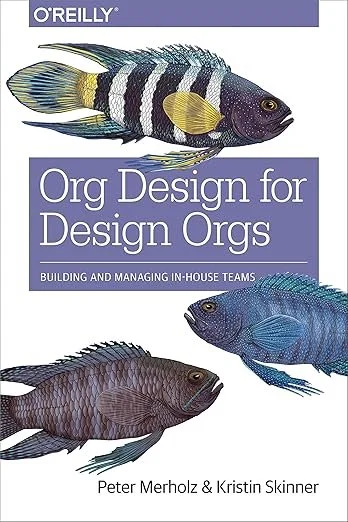Designing a Design Team, Part 1
Creating a Structure and Culture for Success
Building a Team That Works for Your Organization
Design teams don’t exist in a vacuum. Whether inside an ad agency, a product-driven design org, or an in-house tech team, their success depends on how well they fit within the larger organization while also maintaining their own identity and purpose.
In shaping a design team, it’s essential to define:
The team’s mission and goals
Its role within the organization
How it differentiates itself while contributing to broader business objectives
One of the most impactful resources on this topic is Org Design for Design Orgs by Peter Merholz and Kristin Skinner. Their book, and Merholz’s accompanying workshop, provided me with invaluable insights on how to structure, scale, and lead a design team that truly thrives.
Defining the Team’s Purpose: More Than Just a Design Department
Before structuring a team, it’s critical to define why it exists and what it stands for. A great design team isn’t just a group of creatives executing tasks, it should be a strategic function that brings measurable value to the business.
Key questions to consider:
What role does the design team play in the company’s success?
Is design seen as a support function or a strategic driver?
How does the team collaborate with other departments (product, marketing, engineering, account teams, etc.)?
Tailoring Team Culture to the Business Model
A design team’s culture should align with the structure of the organization while still maintaining a strong creative identity.
Ad Agency Model – Fast-paced, client-driven teams require flexibility, strong collaboration with strategy and creative, and the ability to shift between multiple brands.
Product Design Teams – Embedded within a larger product org, these teams need strong UX leadership, defined research practices, and a seat at the table alongside engineering and product management.
In-House Tech Teams – Focused on supporting internal brand or marketing initiatives, these teams often blend brand design, UX, and digital strategy to create long-term impact.
Each setting demands a different approach to leadership, process, and collaboration, but the fundamentals remain the same: a clearly defined mission and a seat at the table where decisions are made.
Creating a Structure That Scales
A well-structured design team must be built for growth—not just to survive the immediate needs of the company, but to evolve as design’s role expands.
Merholz and Skinner’s book outlines three common design team structures:
Centralized – All designers report to a single design leader, creating a strong team culture and consistency across projects.
Embedded – Designers sit within product teams or brand units, working closely with cross-functional partners.
Hybrid – A mix of both, where a core design team sets standards while designers work within specific business units.
The table below compares different design team structures, highlighting their pros, cons, and the types of organizations where they work best.
| Team Structure | How It Works | Best For | Pros | Cons |
|---|---|---|---|---|
| Centralized | All designers report to a single design leader within one team. Design operates as a standalone function. | Agencies, smaller design teams, companies prioritizing brand consistency. | Strong team culture, unified vision, easy knowledge sharing. | Can become disconnected from product or business units, slower to execute cross-functional projects. |
| Embedded | Designers are placed within product, marketing, or business teams, reporting directly to their respective departments. | Large organizations, product-driven companies, tech companies with strong UX focus. | Deep collaboration with cross-functional teams, design aligned with business goals. | Design consistency can suffer, harder to build a strong design culture across the company. |
| Hybrid | A mix of centralized and embedded models—designers report to a design leader but work within product/business teams. | Growing teams, companies scaling design functions, organizations balancing brand and product design. | Maintains a strong design culture while integrating into business functions. | Requires strong leadership to balance priorities, potential for confusion on reporting structures. |
| Agency-Style | Design operates as an internal service provider, taking on projects across departments. | Enterprises, in-house creative teams, marketing-driven organizations. | Flexibility to work on various initiatives, clear ownership of creative projects. | Can be seen as a "vendor" rather than a strategic partner, risk of becoming an order-taking function. |
| Distributed | Designers are spread across different teams with no central design leadership. | Startups, companies without a dedicated design function, organizations prioritizing speed. | High adaptability, close collaboration with non-design teams. | Lack of design leadership, inconsistent standards, potential for misalignment. |
There is no one-size-fits-all approach, but the key is ensuring that design leadership has influence and authority within the organization. Without that, teams become order takers instead of strategic partners.
Balancing Differentiation and Integration
A successful design team must stand out while also fitting in. It needs to bring a unique creative perspective without being siloed or disconnected from business goals.
How does the design team add value beyond execution?
How does it differentiate itself while remaining collaborative with other teams?
How can leadership advocate for design’s role in the organization?
One of the biggest challenges design teams face is being seen as just the “make it pretty” department rather than a strategic function. To avoid this, design leaders need to:
Clearly communicate how design impacts business goals.
Ensure design is involved in strategic discussions early, not just in execution.
Advocate for research, user insights, and design thinking as key business drivers.
Final Thoughts
Creating a well-structured design team isn’t just about hiring great talent—it’s about defining its role, shaping its culture, and ensuring it has influence within the company.
By establishing clear goals, aligning with business objectives, and advocating for design as a strategic function, design leaders can build teams that are not only effective today but also positioned for long-term success.

